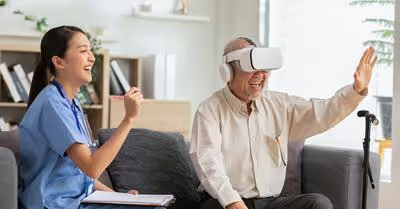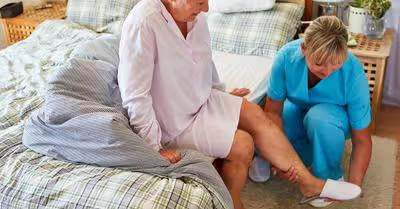Table of Contents
What Type of Yoga Best Suits Seniors?
It doesn’t matter if you as a senior are aiming to be more flexible, stronger, or want to decompress and destress your mind; there is a yoga style for that. However, it may not be easy to know which one is best suited to you with dozens of varying styles.
When selecting a yoga style, you have to ensure that your fitness level and physical condition are the major factors to be considered. It is always important to consult a healthcare provider before engaging in a new exercise routine.
That being said, here are eight forms of yoga that can help you achieve whatever goals you set for yourself:
Kundalini: this type of yoga is known for awareness. Kundalini can be quite attractive to seniors interested in not just the physical but spiritual components of yoga. Kundalini combines meditation, chanting, breathing exercises, and physical postures.
Hatha: Hatha is not exactly a particular style of yoga. It is a generic term given to yoga that combines all forms of physical posture focused yoga. However, in most cases, hatha yoga classes typically feature a series of standing and sitting poses.
These poses are generally about breathing and stretching, rather than aiming to have you lift your leg over your head or increase your heart rate. This is why most people think hatha yoga is best suited for beginners.
- Restorative yoga: this form of yoga is all about slow meditation. It has been designed to help passively ease tension without any need for stretching. Props are generally used to support the body fully.
The poses held are typically held for a long time, with the maximum time being around 10 minutes. This form of yoga is best suited to seniors that are looking to cultivate contentment and relaxation.
- Iyengar: This form of yoga is precise and methodical. It is a yoga form that has a strong emphasis on having the correct form. Practitioners are generally encouraged to use props such as straps, bolsters, incline boards, and blocks to help correct alignment.
Since props are used for poses, Iyengar can be a great yoga style for seniors suffering from chronic conditions such as arthritis.
- Vinyasa: Vinyasa is a yoga style that matches breathing with continuous movements. These movements work in series and flow from one to the other. The pace tends to vary; however, routines are generally quick and fluid.
This yoga style highlights the transitions from one posture to another as well as the poses. It has been likened by some to dancing. It can be physically intensive, but seniors that are reasonably fit should relish the challenge.
- Yin: yin, just like restorative yoga, is slow-paced and concentrates on holding poses. What differs between restorative and yin yoga is that while restorative does not include an active stretch, yin yoga does, stretching the body’s deep connective tissues.
Consistently practicing yin yoga can help alleviate stiffness while enhancing flexibility.
- Ashtanga: this form of yoga is physically challenging and fast-paced as it combines a setlist of poses that are performed in the same manner every time.
Ashtanga can be likened to an acrobatic activity that is intense enough to boost circulation and heart rate. This is why quite a lot of people recommend ashtanga for weight loss. And while it isn’t usually recommended for learners, some seniors enjoy its huge benefits.
- Bikram: Bikram yoga is done in rooms that have been heated to over 100 degrees Fahrenheit, with 40% humidity. With Bikram yoga, you’ll be sweating buckets over the 90 minutes of 26 poses and two breathing techniques.
The main aim of this yoga form is to flush toxins out of the body and strengthen muscles. That being said, there is a risk of overheating, so seniors with heart issues, high or low blood pressure should not do Bikram.
Are There Easier Yoga Options For Seniors?
Every senior is different, and not everybody will be comfortable or healthy enough for the continuous movements of most traditional yoga styles.
Chair yoga can be a much more comfortable option. With chair yoga, seniors with mobility issues or balance challenges can reap benefits from yoga without getting down on the floor. There are many poses, from hip stretches and spinal twists to forward bends and chest openers, which can be modified to suit chair yoga.
Yoga Benefits for Seniors
Yoga can help cultivate a body-mind connection by combining strengthening and stretching postures with relaxation and deep breathing. While it has its roots in Ancient Indian philosophy, yoga concentrates on physical fitness is generally practiced in the west.
The poses, also known as asanas, can be seamlessly adapted or modified to suit a person’s needs, so practicing yoga is safe for seniors regardless of their ability or fitness levels.
Yoga is also a great way to keep your body healthy and strong without suffering from the joint stress associated with other forms of exercise such as jogging or weightlifting. It is also never too late to start practicing yoga.
Here are a few benefits seniors could gain from practicing yoga:
- Improved flexibility: movements in yoga form part of a great stretching routine for seniors. When a pose is held for several breaths, the connective tissues and muscles are encouraged to loosen and relax, which helps increase your range of motion.
The International Journal of Yoga Therapy has published research showing that doing some yoga regularly can significantly boost seniors’ general flexibility.
- Reduced stress and anxiety: yoga, with its mindful breathing and meditation, helps you concentrate on the present while finding inner peace.
A survey by the National Institute of Health discovered that over 85% of people who practiced yoga felt they had decreased levels of stress due to practicing.
Better balance: One of the most visible struggles of age is balance. Many yoga poses designed for seniors concentrate on improving core stability by strengthening the abdominal muscles. This can help you become steadier on your feet, without the risk of falling.
Stronger bones: for seniors concerned about osteoporosis and brittle bones, yoga can be a great way to combat it. When a consistent routine of weight-bearing postures is practiced, bone strength can be bolstered.
Improved sleep: Yoga has been proven to help reduce sleep disturbances, one of the most common complaints of seniors.
Alternative Therapies in Health and Medicine published a study in which people over 60 struggling with insomnia practiced yoga two times a week for three months saw major improvements in their general quality and duration of sleep.
- Enhanced breathing: yoga’s breathing control practices, called pranayama, have been known to improve pulmonary health and expand a senior’s lung capacity.
A study published in The Journal of Human Kinetics found that when older women practiced yoga three times a week for three months, their respiratory function improved significantly.
Basic Yoga Poses For Beginners/Seniors
It is important to remember that basic in this sense doesn’t equate to easy. Every yoga pose is meant to challenge not only your body but your mind as well.
There can be a lot going on, even in seemingly simple poses. This is why it is important to learn yoga from a qualified expert in the beginning. Here are a few of the yoga poses suitable for beginners:
- Tree: this pose is wonderful for developing lower body strength as well as improving balance. There are modified versions that can be done while sitting in or leaning on a chair.
- Mountain: this is perhaps the most simplistic standing pose. It helps to improve your balance and posture.
- Cat-cow: these movements are classic yoga movements that strengthen the abdominal muscles while also promoting spine flexibility. These poses can also be done from a chair.
- Downward-facing dog: this pose aims to stretch your calves, lower back, and hamstrings while opening your chest. If you have wrist issues, this pose can be modified by placing your forearms on the floor.
- Triangle: This pose works your hips and hamstrings as well as strengthening your core. The triangle can help relieve lower back pain and ease sluggish digestion. It can also be done while seated.
- Plank: this pose requires you to get into a pushup position without actually pushing your weight on or off the ground. It can be a great way to develop upper body strength and core stability. The modified version requires you to put your knees on the floor.
- Child’s pose: This pose is generally used as a resting position. However, it can stretch the hips, spine, and lower back. It is a great way to relieve tension, calm your mind and relax.
- Warrior I: Warrior I aims to open your hips and chest while strengthening your thighs, ankles, and calves. If reaching up is a problem, the pose can be modified by putting your hands on your hips.
How Can I Prepare For Yoga?
For seniors looking for the best mix of flexibility and strength exercises suited to them, yoga comes out on top. However, just as with any other physical exercise, you must be prepared. To this end, here are a couple of tips to ensure you are ready for your yoga sessions:
1. Have Your Physical Condition Evaluated
While just about anybody at any age can begin doing yoga, certain movements aren’t advisable for people with particular medical problems.
For example, people suffering from glaucoma should refrain from any head down, or inverted positions as these positions can cause increased pressure on the eyes. This is why it is important to have a word with your instructor and a certified medical professional before any yoga routine is done.
2. Get Your Gear Together
To do yoga, you will require stretchy, comfortable clothing. Fitted clothes are best suited for yoga, particularly tops, as you are bound to be bending in various positions, and the last thing you need is your top falling to your eyes.
Jogging pants or leggings with a fitted tank top or t-shirt are great yoga clothing choices. You don’t need special footwear for yoga as it is generally performed barefoot. Nevertheless, you can use non-slip socks if you are worried about losing your footing.
You’ll also need to bring a yoga mat along with you. This generally depends on the studio you use, as some provide yoga mats for free, and others expect that you bring yours.
Additionally, many individuals prefer bringing theirs for hygienic reasons. When searching for a yoga mat, it is best to have sufficiently long to support your entire body when you lie down.
It is also important that your mat has enough friction so that it doesn’t slip when you attempt a pose. The material makeup of your mat should also be considered; inexpensive mats are usually constructed of PVC. However, if you are worried about the environment, you could get mats made of jute, cotton, or rubber.
Most mats have a 1/8 thickness, but some are slightly thicker or thinner. Thicker mats provide additional support for those with sensitive joints, but they can also make it a little bit more difficult to attempt certain balance poses. They can also be harder to move around as they are bulkier.
Portability doesn’t matter if you practice yoga within your home, but it can become an issue if you practice yoga at a studio.
3. Find A Qualified And Experienced Teacher
It is imperative that your instructor is trained and understands the peculiar challenges seniors face when attempting yoga.
Numerous directories hold the list of yoga instructors all over the United States that meet this standard. You can also find yoga instructors that have undertaken special training to teach yoga programs to seniors.
Ask your potential teachers if they have any experience in teaching individuals with health problems or seniors. You could also ask them how long they have been yoga instructors.
If possible, you should observe your potential class to get an idea of the teacher’s methods and techniques. Once you select an instructor, ensure that you inform them of any physical or health limitations you might have, like balance issues, arthritis, high blood pressure, or back pain.
Informing them of your situation helps an experienced instructor recommend the best yoga styles and poses suited to you.
4. Slow And Steady
Becoming flexible to do yoga is only possible when you ease into it. For example, if you aim to bend forward to touch your toes, you can begin by placing your hands on your thighs.
When you do this, take a couple of deep breaths and then move to touch your knees. Take some time in this position by breathing slowly and then reach for your shin. This incremental posture ensures that you avoid overstretching.
Ensure that you sufficiently rest before each new pose. You should also never rush your postures.
When practicing your poses, do not add any movements till your body has become fully adjusted to the routine. It is also important that you note that yoga isn’t about maintaining the pace around you. Rather it is about going at a pace that is best for you.
A yoga pose shouldn’t hurt. While you might feel challenged, it shouldn’t get to the point where you feel strained. The moment you cannot comfortably do a particular pose, ask the instructor for an altered version.
The great thing about yoga is that nearly every pose can be modified in a way that accommodates a vast array of physical conditions. You shouldn’t be reluctant to use props such as blocks, walls, chairs, or straps for extra support.
Recent Articles
















